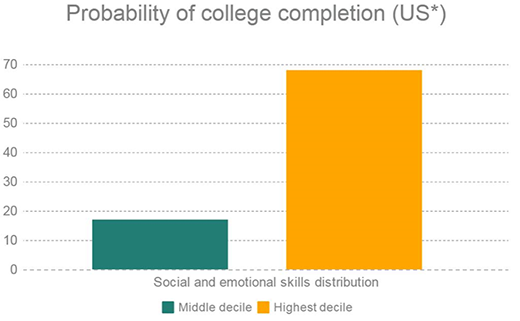by Anna Choi
Analyst, Directorate for Education and Skills, OECD
Koji Miyamoto
Analyst, Directorate for Education and Skills, OECD
Analyst, Directorate for Education and Skills, OECD
Koji Miyamoto
Analyst, Directorate for Education and Skills, OECD
Common sense and hard evidence point to the significant impact of socio-emotional skills such as perseverance and responsibility on children's lifetime success. Empowered children are much more likely to finish college, maintain healthy lifestyles and be happy. Both parental and teacher experiences as well as emerging studies also underlie that social and emotional skills can be particularly malleable from childhood until adolescence.
The OECD report: "Skills for progress report" shows that American high school students who were at the highest decile of social and emotional skills distribution are 4 times more likely to self-report completing college than those who are in the middle decile (median). Needless to say, a growing number of evidence indicate how these skills can have lasting positive effects on a wide-range of outcomes, such as life satisfaction, emotional health, and well-being (see the report for further evidence and review).
 |
| *Sample limited to white males with at least a high school diploma |
Moreover, we have started to understand that some of these social and emotional skills that drive children's lifetime success are malleable and can be developed during childhood and adolescence. Yet currently, there appears to be only a few countries and school districts that have wide-ranging policies in place to foster social and emotional skills. This may in part be due to the fact that existing evidence doesn’t yet provide sufficient details on what works, for which skills, for whom, when and under what conditions. This may come as a surprise since social and emotional skills are not necessarily difficult to define or measure than cognitive skills for which we have good evidence-base. Perhaps we simply have not paid as much attention to conceptualise measures of conscientiousness or leadership skills as algebra or reading comprehension?
Why is the evidence base still limited? An important reason is likely to be the lack of reliable and well-defined measures of the range of social and emotional skills that matter for people's lives. The most popular measures we currently use are children's self-reports or ratings by parents and teachers. While these measures can provide valuable information, they also can be subject to a variety of biases including acquiescence, social desirability, faking and reference groups. There are a range of methods that are designed to account for these biases (e.g., anchoring vignettes and forced choices), but they have not been extensively tested. There are also measures that are arguably designed to directly capture these skills (e.g., performance tests and experimental games), but they have also not been subject to extensive tests.
The OECD's Longitudinal Study of Social and Emotional Skills in Cities is addressing the measurement challenges by developing valid and reliable measures of social and emotional skills that are comparable across different cultural contexts. This study will explore a variety of methods to measure these skills to better understand their development during childhood and adolescence as well as the learning contexts that could help drive this process. The OECD will spend 2016-19 on developing measurement instruments, which will be followed by the longitudinal follow-up of primary and secondary school children in grade 1 and 7 in several major cities around the world. In parallel, the OECD is working on various projects designed to understand how different learning contexts (such as family, teachers, school, and community) can help improve children's social and emotional skills using existing longitudinal data sets.
By developing robust measurement tools and longitudinal data through the Longitudinal Study of Social and Emotional Skills in Cities, we can help not only students, parents, and teachers, but also employers and society at large. Through this study, the students can have a better picture about their capabilities and their development over time. The parents can better understand how the home learning contexts related to the development of these skills and how other learning contexts are coherent with those at home. Teachers can use different measurement tools to define and assess student's social and emotional skills and provide insights on how to embed pedagogies into existing classes and curriculum to teach these skills. This study can also help school administrators, policymakers, and community leaders to better learn about how various learning contexts in schools and communities can work together and enhance these skills. Moreover, results from this study can inform employers about the types of skills the future employees may bring and enable companies to better prepare training programmes and adapt the workplace. Finally, the society as a whole can benefit from improvements via reduced inequality, happier and more responsible citizens.
Would a development of perfect metrics and evidence-base necessarily lead to a wide stakeholder engagement in social and emotional learning? For this to happen, we also need to conceptualise these skills in a way that educators can better understand and relate them into ongoing instructional systems and social and emotional learning practices.
For more information:
Skills for Social Progress: The Power of Social and Emotional Skills
OECD working paper: Fostering and Measuring Skills: Improving Cognitive and Non-Cognitive Skills to Promote Lifetime Success, by Tim Kautz et al.
Chart source: Skills for progress report (OECD, 2015)




